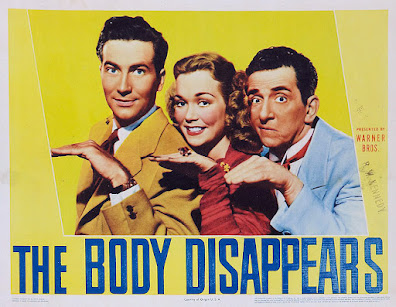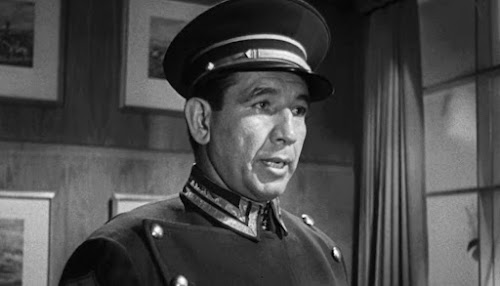Imagine a movie where Willie Best plays Igor to Edward Everett Horton’s Dr. Frankenstein who is trying to reanimate dead bodies. Instead he creates an Invisible Man who falls in love with Jane Wyman who then ecstatically sheds her undergarments to become The Invisible Woman. Well, imagine no more as The Body Disappears (1941) is that film.
With all those horror tropes mixed together in one story you’d think that this fluffy Warner Bros. romantic comedy would be better known, or at least better referenced by fans of the Universal Monsters whom this film is gently riffing on. I suspect that if this film had of been made two years later, Willie Best would have turned into a werewolf as well!
Alas, despite checking many of the iconic horror touchstones (including a homage to the famous ‘It’s Alive!’ scene), its suburban university town setting keeps it several steps removed from that genre. With no crackling laboratory machinery or megalomaniacal rants due to the effects of monocane, most audiences at the time would have probably completely missed the multiple hat tips to the classic monster films.
The story is only slightly more complicated than it needs to be. Jane Shotesbury’s (Wyman) absent-minded professor father (EE Horton) is working on a formula to bring the dead back to life. When he and his manservant Willie (Best) borrow a corpse from the med school’s cadaver bank, it turns out to be the ‘only wishes he was dead’, severely hungover Peter Dehaven (Jeffery Lynn), placed there as a gag by his buddies after his stag party. Horton’s resuscitating formula not only wakes Peter up, but turns him invisible which in turn complicates the police search for him when Pete fails to turn up for his wedding. Jane and Peter fall in love, of course, but they still have to deal with Pete's gold digging fiancé, Jane's father being suspected of murdering the disappeared Peter, and Jane becoming invisible. All this leads to a lot of cross-purpose chaos that propels the otherwise standard 1940’s ‘B’ movie romcom plot. The Body Disappears tries hard to reach screwball intensity, but it never quite ignites. Despite that, it still makes for a pleasant, although unsophisticated, diversion thanks to its modest 72 minute running time.
The most interesting parts of this film are those you don’t
see (not a necessarily a bad thing) as the naked (but invisible) Jane and Pete scramble
to free her father. An invisible Jane flaunts her lingerie and then doffs it
while driving the rescue car, throwing it over the head and around the neck of poor Willie Best in
the back seat of the seemingly driverless vehicle. Despite the fast pace of the
film’s third act, it’s hard to understand how the censors could have let an
unmarried, naked couple sit literally (butt) cheek to cheek and in the presence
of a black man.
Where the movie does succeed is thanks to the services of Wyman, Horton and Willie Best.
Wyman has little to do here but look gorgeous, which she succeeds at with gusto. Her introduction is in a ‘designed-to-be-noticed’, cut to the waist, backless dress that once seen makes one forget that her character is as light and thin as a soap bubble. In the early 1940’s, Wyman was still trading on her effervescing, scatter-brained, ray of sunshine persona that had originally gotten her noticed. She used it to give Glenda Farrell a run for her money as Torchy Blaine in the last official film in that series (….Plays With Dynamite, 1940). For those of you who enjoyed her performance in that film (I did!), I suggest that you check out Private Detective (1941). When that last Torchy film failed to be a blockbuster, Warner Bros simply changed the character’s name to ‘Jinx’ Winslow and filmed the next Torchy script with Wyman playing essentially the same character.
Most of the comedy in The Body Disappears is left to Horton and Best, either separately or together. No one played flustered, absent-minded, self-important boobs like EEH. There is an entire scene towards the end of the film where EEH’s character has to defend himself from insanity charges brought against him by his university colleagues that feels tacked on in an attempt to pad out the film's running time with extra ‘screwballiness’. As much fun as is it to watch EEH in these situations, the script by Scott (The Ghost of Frankenstein, 1942) Darling and Erna Lazarus does not give him much to work with (or against). It does, however, accomplish the plot point of getting him into a sanatorium so Jane can use his invisibility formula to break him out.
The real star of the film is perennial ‘Stepin Fetchit’ character actor/comedian, Willie Best (above). Despite having as much, or more, screen time than any of the other actors in the film, he is only 8th billed. Mercifully, his stereotypical, dim-witted black comic relief is significantly dialed back and he gets all the best lines in the film as he reacts (not inappropriately) to the nonsense going on around him. I laughed out loud when he first comes upon Pete’s ‘corpse’ and mutters, “This one's got a lily in his hands. He may be dead, but he's neat about it.”
For Willie Best and most black actors of the day, serious roles were mostly non-existent, with women being relegated to, at best, servants or nursemaids, and the men (e.g., Mantan Moorland) being confined to the stereotype ‘scared & sputtering’ comic relief role. Although the characters they played might now be repugnant, that doesn’t take away those actors considerable skills in carrying them off. Best play this role to better effect in the previous year's Bob Hope/Paulette Goddard film, The Ghost Breakers (1940) where he ends up being the inadvertent hero of the story.
Some of the other actors in the film to call out here include Herbert (Dennis the Menace’s father) Anderson as Peter’s medical student-best friend who puts Pete in the morgue after he carries out one too many practical jokes at his stage party; Craig (Peter Gunn) Stevens as Peter’s fiancé’s secret boyfriend; David (The Mad Ghoul, 1943) Bruce; Todd (From Hell It Came, 1957) Andrews; and William (20 Million Miles To Earth, 1957) Hopper. Also watch for Natalie (Gillian’s Island’s Mrs. Howell) Schafer in her first full length feature film role, and blink-and-you’ll-miss-her Leslie Brooks from one of my favourite poverty row noir’s, Blonde Ice (1948), as a bridesmaid.
Is The Body Disappears Worth My Time? It’s a nice Sunday
afternoon timewaster, especially for those who love the old Universal Monster
films. Willie Best steals the show, but Jane Wyman looks stunning and Edward
Everett Horton does his best to keep the comedy going. Top billed Jeffery Lynn
is so bland and boring that I forgot to mention him in this review. Since he’s
invisible for most of the film he’s easy to overlook.
The invisibility special effects are substandard, but they don't
distract from the story where their believability is largely irrelevant. The direction by D. Ross
Lederman and the cinematography by Allen G. Siegler are both competent and
completely in keeping with their extensive, mostly B-picture work.
Availability: I can’t confirm an official DVD release. Occasionally a nice copy will be posted (and taken down) on YouTube, so keep a look out for it.








.jpg)

.jpg)









